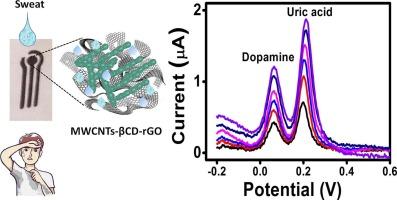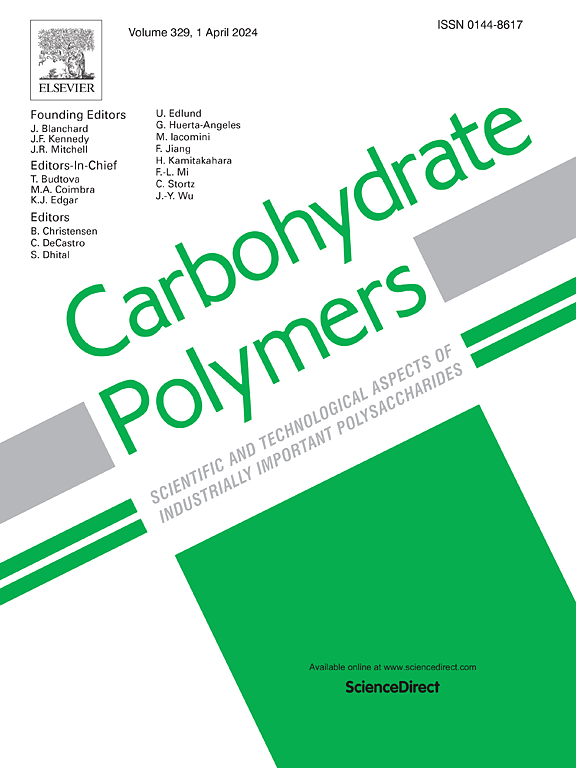mwcnts - β -环糊精-还原氧化石墨烯凝胶电化学传感器用于同时检测人体汗液样品中的多巴胺和尿酸
IF 10.7
1区 化学
Q1 CHEMISTRY, APPLIED
引用次数: 0
摘要
准确测定生物样品中的多巴胺(DA)和尿酸(UA)分别对诊断神经退行性疾病和痛风至关重要。在这里,我们报告了一种高灵敏度和廉价的柔性丝网印刷传感器,用于测定汗液样品中的DA和UA。以最佳“好溶剂”和“差溶剂”的比例,通过β -环糊精(βCD)自聚合合成了还原氧化石墨烯(rGO)复合凝胶。将多壁碳纳米管(MWCNTs)作为导电填料掺入复合材料中。MWCNTs-βCD-rGO凝胶通过客体-宿主相互作用在电极表面提供对DA和UA的选择性生物识别。采用XRD、TGA、FTIR、UV-Vis、1H NMR、FESEM、XPS和光学显微镜对凝胶进行了表征。柔性印刷传感器在0.25 ~ 16 μM范围内具有良好的线性DA检测效果,相关系数(R2)为0.9890,检出限(LoD)为0.08 μM,灵敏度为3.63 μA μM−1 cm−2。同样,UA校准在50 ~ 700 μM范围内线性检测,R2为0.9860,LoD为0.078 μM,灵敏度为0.118 μA μM−1 cm−2。SPE/MWCNTs-β cd - rgo传感器可同时测定运动诱导汗液样品中的DA和UA。该传感器在人体汗液中具有良好的重复性和令人满意的回收率。本文章由计算机程序翻译,如有差异,请以英文原文为准。

MWCNTs-Beta-Cyclodextrin-reduced graphene oxide gel based electrochemical sensor for simultaneous detection of dopamine and uric acid in human sweat samples
Accurate determination of dopamine (DA) and uric acid (UA) in biological samples is crucial in diagnosing neurodegenerative disorders and gout, respectively. Here we report a highly sensitive and inexpensive, flexible screen-printed sensor for determining DA and UA in sweat samples. Beta-cyclodextrin-based (βCD) composite gel with reduced graphene oxide (rGO) was synthesized by self-polymerization of βCD at an optimum ratio of “good” and “poor solvent”. Multiwall carbon nanotubes (MWCNTs) were incorporated into the composite as a conductive filler. The MWCNTs-βCD-rGO gel provides selective biorecognition of DA and UA at the electrode surface through guest-host interaction. The gels were characterized by XRD, TGA, FTIR, UV–Vis, 1H NMR, FESEM, XPS and optical microscopy. The flexible printed sensor showed linear DA detection in the range 0.25 to 16 μM with a correlation coefficient (R2) of 0.9890, limit of detection (LoD) of 0.08 μM and sensitivity of 3.63 μA μM−1 cm−2. Similarly, UA calibration showed linear detection from 50 to 700 μM with a R2 value of 0.9860, LoD of 0.078 μM and sensitivity of 0.118 μA μM−1 cm−2. The SPE/MWCNTs-βCD-rGOsensor showed simultaneous determination of DA and UA from exercise induced sweat samples. The proposed sensor demonstrated excellent repeatability and satisfactory recoveries in human sweat.
求助全文
通过发布文献求助,成功后即可免费获取论文全文。
去求助
来源期刊

Carbohydrate Polymers
化学-高分子科学
CiteScore
22.40
自引率
8.00%
发文量
1286
审稿时长
47 days
期刊介绍:
Carbohydrate Polymers stands as a prominent journal in the glycoscience field, dedicated to exploring and harnessing the potential of polysaccharides with applications spanning bioenergy, bioplastics, biomaterials, biorefining, chemistry, drug delivery, food, health, nanotechnology, packaging, paper, pharmaceuticals, medicine, oil recovery, textiles, tissue engineering, wood, and various aspects of glycoscience.
The journal emphasizes the central role of well-characterized carbohydrate polymers, highlighting their significance as the primary focus rather than a peripheral topic. Each paper must prominently feature at least one named carbohydrate polymer, evident in both citation and title, with a commitment to innovative research that advances scientific knowledge.
 求助内容:
求助内容: 应助结果提醒方式:
应助结果提醒方式:


